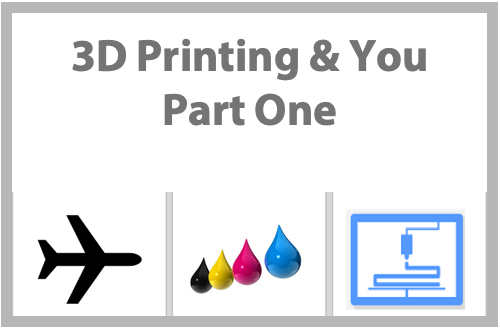You or someone you know is wearing a 3D printed implant or prosthetic. You may have flown at 38,000 feet on a jet with 3D printed engine components. But what about 3D printing in your business?
Fact: every hearing aid manufacturer uses 3D printing to produce customized shells. Patients who wear two aids, as I do, have two different custom speaker shells, one for the left ear, one for the right. More than 100,000 patients have hip implants with metal, 3D printed, acetabular cups.
Jet Fact: GE Aviation has incorporated more than 30,000 metal 3D printed fuel nozzles – operating at 3,000 degrees F – in their LEAP commercial jet engines. 19 fuel nozzles per engine, to be exact. 4,000 of the 5,000 jigs and fixtures that Lockheed Martin uses in Fort Worth, Texas to assemble F-35 fighter jets for the US armed forces and allies are 3D printed.
Jetting Fact: Every inkjet printing press, made by any inkjet OEM (and presses made by any analog or digital press manufacturer) starts with drawings, many, many drawings. Ultimately the drawings are converted into a prototype, beginning the process of developing the presses that you purchased. The same holds true for your prepress, finishing, assembly and shipping equipment.
Name a newer piece of printing equipment and the odds are great that the manufacturer used 3D printing to create prototypes. One manufacturer of point-of-sale printers used by the retail banking industry not only prototypes with 3D printing, they also 3D print the jigs and fixtures used to assemble the printers, 3D print many of the printers’ plastic parts, and intend to use 3D printing to produce metal parts.
Where Can 3D Printing Be Used In My Printing Business?
So, the first place to use 3D printing in your printing business is for your internal needs such as prototyping, maintenance and customization.
- Prototype modifications to your commercially available equipment: If you are like most of your peers, a maintenance person or operator has modified a press or bindery machine so it produces the unique job that your customer requires. 3D printed prototypes facilitate that process with rapid iterations, even under deadline. And the devices are relatively inexpensive, with quality material extrusion 3D printers using plastic starting around $2,000.
- Tools, jigs and fixtures that improve performance and quality: Few are the jobs that come off the press, ready to box and ship. Most require some kind of bindery or assembly. These value-adding and revenue-generating services can be more profitable when 3D printed tools, jigs or fixtures are used.
Machine and assembly operators become more efficient, and quality improves when they are given what they need to do the job. (Why do you think Lockheed Martin uses 4,000 of them to assemble fighter jets?) And if yours is a larger printing operation, with pick-and-pack robotic arms and the like, 3D printed end-of-arm grippers can be custom designed to the customers’ specific jobs.
- Replacement parts: Back in the day, I worked as an operations manager for one of the country’s largest producers of direct mail campaigns for non-profit organizations (think of the Paralyzed Veterans of America, the March of Dimes, the Red Cross and many others). We used 24 station Bell & Howell swing-arm inserters to stuff greeting cards, bundled envelopes, return address labels and, of course, the donor “ask letter” into mailers.
With equipment that were workhorses but as old as the hills, we had to fabricate the replacement parts for the inserters ourselves. Life would have been so much easier (and getting back into production so much quicker) if we had been able to 3D print broken parts in plastic or metal. But, today, you can do that.
Now that we’ve skimmed the surface on the many places you can see 3D printing (3DP) in your everyday life, and how 3D capabilities can drive efficiencies in your everyday business, we can take a look at the potential for 3D applications that align with your 2D business. Stay tuned for my next post 3DP and You.

